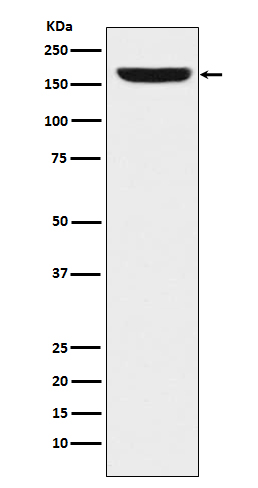REST / NRSF Rabbit mAb [69AH]Cat NO.: A85195
Western blot(SDS PAGE) analysis of extracts from HeLa cell lysate.Using REST / NRSF Rabbit mAb [69AH]at dilution of 1:1000 incubated at 4℃ over night.
Product information
Protein names :NRSF; RE1 silencing transcription factor; Repressor binding to the X2 box; rest; X2 box repressor; XBR;
UniProtID :Q13127
MASS(da) :121,872
MW(kDa) :160kDa
Form :Liquid
Purification :Affinity-chromatography
Host :Rabbit
Isotype : IgG
sensitivity :Endogenous
Reactivity :Human
- ApplicationDilution
- 免疫印迹(WB)1:1000-2000
- The optimal dilutions should be determined by the end user
Specificity :Antibody is produced by immunizing animals with A synthesized peptide derived from human REST / NRSF
Storage :Antibody store in 10 mM PBS, 0.5mg/ml BSA, 50% glycerol. Shipped at 4°C. Store at-20°C or -80°C. Products are valid for one natural year of receipt.Avoid repeated freeze / thaw cycles.
WB Positive detected :HeLa cell lysate.
Function : Transcriptional repressor which binds neuron-restrictive silencer element (NRSE) and represses neuronal gene transcription in non-neuronal cells (PubMed:12399542, PubMed:26551668, PubMed:7697725, PubMed:7871435, PubMed:8568247, PubMed:11741002, PubMed:11779185). Restricts the expression of neuronal genes by associating with two distinct corepressors, SIN3A and RCOR1, which in turn recruit histone deacetylase to the promoters of REST-regulated genes (PubMed:10449787, PubMed:10734093). Mediates repression by recruiting the BHC complex at RE1/NRSE sites which acts by deacetylating and demethylating specific sites on histones, thereby acting as a chromatin modifier (By similarity). Transcriptional repression by REST-CDYL via the recruitment of histone methyltransferase EHMT2 may be important in transformation suppression (PubMed:19061646). Represses the expression of SRRM4 in non-neural cells to prevent the activation of neural-specific splicing events and to prevent production of REST isoform 3 (By similarity). Repressor activity may be inhibited by forming heterodimers with isoform 3, thereby preventing binding to NRSE or binding to corepressors and leading to derepression of target genes (PubMed:11779185). Also maintains repression of neuronal genes in neural stem cells, and allows transcription and differentiation into neurons by dissociation from RE1/NRSE sites of target genes (By similarity). Thereby is involved in maintaining the quiescent state of adult neural stem cells and preventing premature differentiation into mature neurons (PubMed:21258371). Plays a role in the developmental switch in synaptic NMDA receptor composition during postnatal development, by repressing GRIN2B expression and thereby altering NMDA receptor properties from containing primarily GRIN2B to primarily GRIN2A subunits (By similarity). Acts as a regulator of osteoblast differentiation (By similarity). Key repressor of gene expression in hypoxia,represses genes in hypoxia by direct binding to an RE1/NRSE site on their promoter regions (PubMed:27531581). May also function in stress resistance in the brain during aging,possibly by regulating expression of genes involved in cell death and in the stress response (PubMed:24670762). Repressor of gene expression in the hippocampus after ischemia by directly binding to RE1/NRSE sites and recruiting SIN3A and RCOR1 to promoters of target genes, thereby promoting changes in chromatin modifications and ischemia-induced cell death (By similarity). After ischemia, might play a role in repression of miR-132 expression in hippocampal neurons, thereby leading to neuronal cell death (By similarity). Negatively regulates the expression of SRRM3 in breast cancer cell lines (PubMed:26053433).., [Isoform 3]: Binds to the 3' region of the neuron-restrictive silencer element (NRSE), with lower affinity than full-length REST isoform 1 (By similarity). Exhibits weaker repressor activity compared to isoform 1 (PubMed:11779185). May negatively regulate the repressor activity of isoform 1 by binding to isoform 1, thereby preventing its binding to NRSE and leading to derepression of target genes (PubMed:11779185). However, in another study, does not appear to be implicated in repressor activity of a NRSE motif-containing reporter construct nor in inhibitory activity on the isoform 1 transcriptional repressor activity (PubMed:11741002). Post-transcriptional inactivation of REST by SRRM4-dependent alternative splicing into isoform 3 is required in mechanosensory hair cells in the inner ear for derepression of neuronal genes and hearing (By similarity)..
Tissue specificity :Expressed in neurons of the prefrontal cortex, in hippocampal pyramidal neurons, dentate gyrus granule neurons and cerebellar Purkinje and granule neurons (at protein level) (PubMed:24670762). Expressed in dopaminergic neurons of the substantia nigra (at protein level) (PubMed:30684677). Expressed in neural progenitor cells (at protein level) (PubMed:21258371). In patients suffering from Alzheimer disease, frontotemporal dementia or dementia with Lewy bodies, decreased nuclear levels have been observed in neurons of the prefrontal cortex and the hippocampus, but not in neurons of the dentate gyrus and cerebellum (at protein level) (PubMed:24670762). In patients with Parkinson disease or dementia with Lewy bodies, decreased nuclear levels have been observed in dopaminergic neurons and in cortical neurons and localization to Lewy bodies and pale bodies was detected (at protein level) (PubMed:30684677). Expressed at higher levels in weakly invasive breast cancer cell lines and at lower levels in highly invasive breast cancer lines (at protein level) (PubMed:26053433). Ubiquitous (PubMed:8568247). Expressed at higher levels in the tissues of the lymphocytic compartment, including spleen, thymus, peripheral blood lymphocytes and ovary (PubMed:8568247)..
Subcellular locationi :Nucleus. Cytoplasm.
IMPORTANT: For western blots, incubate membrane with diluted primary antibody in 1% w/v BSA, 1X TBST at 4°C overnight.


